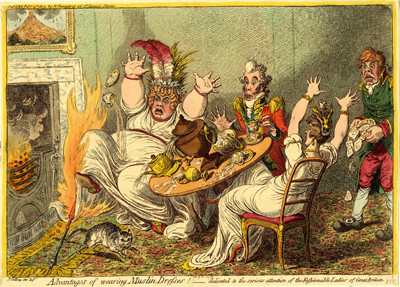Advantages of Wearing Muslin Dresses!
In the January 11 issue of the Morning Post and Gazetteer (about a month before Gillray's print appeared), readers could have seen the following notice.
The number of persons burned to death has greatly increased since the introduction of light clothing. Ladies are forced to a nearer enjoyment of the fire and the thin muslin transparency is in a blaze in a moment. (p. 2)
The same timely warning appeared in Courier and Evening Gazette on the same day in January. And it certainly no accident that Gillray's print followed soon thereafter, appearing in what was typically the coldest month of the year in Britain.

© Trustees of the British Museum
Even before the Treaty of Amiens made travel and commercial exchange possible again between London and Paris, French fashion in clothing had a substantial influence on the tastes of British ladies of fashion. And in the last half of the 1790s, French fashion shifted dramatically away from "the stiffly boned corsets and brightly colored satins and other heavy fabrics that were in style in the Ancien Régime and towards a barer, sparer classical style resembling Greek statuary with high waists and clinging skirts.
Muslin fabric was the perfect choice for this style, because it was soft, light, and flowing, taking its form from the natural figure. And in England it was readily available through the British East India Company. But because of its thin, open weave, it was also highly flammable. And as Rae Nudson noted, quoting Deirdre Kelly, in her "A History of Women Who Burned to Death in Flammable Dresses,"
It's not a build-up like, 'Oh my gosh, you're smoking, let me tamp that out.' It's like, 'Ahh!' Your girlfriend beside you is a ball of fire, and you're now a ball of fire, and boom boom boom boom boom boom boom, they're all balls of fire.
In a hot climate like India, the flammability of muslin was not as much of an issue. But in England where the winter months were cold and raw, the fashionable, barely covered style led women to approach as near to the fire as they could with the disastrous results seen in Gillray's print.
Like numerous comic caricatures by Rowlandson, Gillray here takes a serious, potentially fatal event and derives humor from it. He does so by suppressing the impulse to sympathize with the women and men around the tea table by a variety of distancing techniques: the exaggeration of form and feature which tells us that these are cartoon people with cartoon reactions, with distracting details such as the flying cup and saucer, the overturned table with the urn and teapot pouring out their contents simultaneously, the cat knocking over the poker, the servant spilling the muffins, and with a painting on the wall coincidentally providing an explosive analogue of the event below.
Sources and Reading
- Commentary from the British Museum on Advantages of Wearing Muslin Dresses!.
- "Muslin," Wikipedia
- "Muslin: A Beautiful & Versatile Cloth for Regency Fashion," Jane Austen's World
- "Directoire Style Fashion of Women in 1795-1800" HiSoUR.com
- "1800-1809," Fashion History Timeline
- Rae Nudson, "A History of Women Who Burned to Death in Flammable Dresses," Racked
- Thomas Wright and R.H. Evans, Historical and Descriptive Account of the Caricatures of James Gillray #513.
- Thomas Wright and Joseph Grego, The Works of James Gillray, the Caricaturist; With the History of His Life and Times, p. 289.
Comments & Corrections
NOTE: Comments and/or corrections are always appreciated. To make that easier, I have included a form below that you can use. I promise never to share any of the info provided without your express permission.